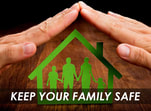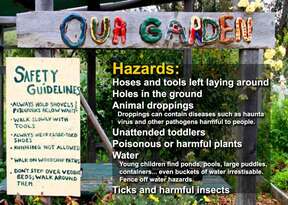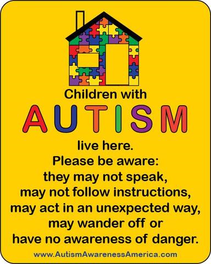Each year, children are injured by hazards in and around the home. The good news is that the risk of injury can be reduced or prevented by using child-safety devices and reminding older children in the house to re-secure safety devices after disabling them.
Most of these safety devices are easy to find and are relatively inexpensive. You can buy them at hardware stores, baby equipment shops, supermarkets, drug stores, home improvement stores, on the Internet and through mail order catalogs. Safety devices should be sturdy enough to hinder access and yet easy for you to use. Voice warning alarms can be programmed with your voice, or that of their favorite beloved character.
To be effective, they must be properly installed. Follow installation instructions carefully. Remember, too, that NO device is completely childproof; determined youngsters have been known to overcome or disable them. Here are some child safety devices that can help reduce injuries to young children. But, DO NOT count on them 100%. Parents and caregivers still need to be hyper-vigilant to what kids are up to, wherever they are.
- Latches & Locks for cabinets and drawers in kitchens, bathrooms, and other areas to help prevent poisonings and other injuries. Safety latches and locks on cabinets and drawers can help prevent children from climbing and or gaining access to medicines, household cleaners, detergent pods & powders, matches, or cigarette lighters, as well as knives and other sharp objects. Even products with child-resistant packaging should be locked away and kept out of reach. This packaging is NOT childproof. Look for safety latches and locks that adults can easily install and use, but are sturdy enough to withstand pulls and tugs from children.
- Gates to help prevent falls down stairs and to keep children from entering rooms and other areas with possible dangers. Look for safety gates that children cannot dislodge easily, but that adults can open and close without difficulty. For the top of stairs, only use gates that screw to the wall. Use safety gates that meet current safety standards. Replace older safety gates that have “V” shapes that are large enough to entrap a child's head and neck.
- Door Knob Covers and Door Locks to help prevent children from entering rooms and other areas with possible dangers. Door knob covers and door locks can help keep children away from places with hazards. Be sure the door knob cover is sturdy, and allows a door to be opened quickly by an adult in case of emergency.
- Anti-Scald Devices for faucets and shower heads and set your water heater temperature to 120 degrees Fahrenheit to help prevent burns from hot water. Anti-scald devices for regulating water temperature can help reduce the likelihood of burns.
- Smoke Alarms & Carbon Monoxide (CO) Alarms on every level of your home, inside each bedroom, and outside sleeping areas to alert you to fires. Smoke alarms are essential safety devices for protection against fire deaths and injuries. Check them once a month to make sure they're working. Change batteries at least once a year or consider using 10-year batteries for alarms. (RESEARCH BEST METHODS TO CHECK YOUR ALARMS. You can find sources online, on YouTube, at your local fire station.)
- Window Guards and Safety Netting to help prevent falls from windows, balconies, decks, and landings. Check these safety devices frequently to make sure they are secure and properly installed and maintained. Limit window openings to four inches or less, including the space between the window guard bars. If you have window guards, be sure at least one window in each room can be easily used for escape in a fire. Window screens are NOT effective for preventing children from falling out of windows.
- Corner and Edge Bumpers to help prevent injuries from falls against sharp edges of furniture and fireplaces. Be sure to look for bumpers that stay securely on furniture or hearth edges.
- Outlet Covers and Outlet Plates to help prevent electrocution. Outlet covers and outlet plates can help protect children from electrical shock and possible electrocution. Be sure outlet protectors CANNOT be easily removed by children and are large enough so that children CANNOT choke on them. If you are replacing receptacles, use a tamper-resistant type. You may also want to replace on-and-off toggle wall light switches with dimmer dials. This will help discourage children with light switch obsessions.
- Carbon Monoxide (CO) Alarm to help prevent CO poisoning. All consumers should install CO alarms next to their Smoke Detectors, near sleeping areas in their homes. Change batteries at least once a year.
- Cordless Window Coverings in homes with young children, in order to help prevent strangulation. Children can wrap window covering cords around their necks or can pull cords that are NOT clearly visible but are accessible and become entangled in the loops.
- Anchors to Avoid Furniture and Appliance Tip-Overs. Furniture, TVs and small appliances can tip over and crush young children. Deaths and injuries occur when children climb into or onto washers, dryers, or fireplaces; under beds, or fall against or pull themselves up on television stands, shelves, bookcases, dressers, desks, chests and ranges. For added security, anchor these products to the floor or attach them to a wall with furniture brackets or safety straps. May also consider plastic shields in front of TVs, bookcases, and curio cabinets. Check all beds and bedroom furniture for safety.
- Layers of Protection with Pools and Spas. A barrier completely surrounding the pool or spa including a tall fence with self-closing, self-latching gates is essential. If the house serves as a side of the barrier, doors heading to the pool should have an alarm or the pool should have a power safety cover. Pool alarms can serve as an additional layer of protection. Sliding glass doors, with visual and locks that must be re-secured after each use. Another layer of protection is to be certified in Cardio Pulmonary Resuscitation (CPR) and Automated External Defibrillator (AED).
But I noticed it was too quiet. Andrea should have been playing near me while I worked. She was NOT on the swing. She was NOT on the trampoline.
I bolted into the house and searched everywhere for her. I tried NOT to panic, but I had a sinking feeling in my gut. I dashed back outside to yell at the neighbor, “Hey, have you seen Andrea?”
We both started running to our backyards. We hollered for Andrea, but no answer. There was a board missing in the neighbor’s fence around his pool.
“Call 911” Joe shouted. “I’ve got her, but she’s not breathing!” the ambulance arrived with sirens and flashing lights. Two men jumped out and began mouth-to-mouth resuscitation on Andrea.
Time stood still as I could only watch helplessly. She had not been breathing for several minutes. Then she made a gurgling noise. She coughed and sputtered, trying to get air. She opened her eyes. The CPR had been successful.
< My Thoughts > “CPR had been successful.”
Learn Cardio Pulmonary Resuscitation (CPR) for baby, child, & adult; each requires different skills. Included in that should be Basic First Aid because of unusual bleeding which can occur due to some side effects of your child’s medication. Of course, all of this prevention is supposed to help your child feel SAFE to explore their environment. Try to balance this with plenty of SAFE play, and adventuresome activities.
The Red Cross, most hospitals, and many private agencies teach these CPR classes. There are classes which includes Automated External Defibrillator (AED) training and purchase. These trainings should also include learning what to do if a child or adult is choking; such as the ‘abdominal thrust’ known as the Heimlich maneuver. And, stay certified.
Trainings can include Basic First Aid (Medications can cause unusual wound bleeding… know how to treat ‘bite’ injuries.); make certain that all trainings show you how to deal with BOTH children and adults. These classes are all offered online, also. But this is something you should to do in person.
Retrieved from – https://www.cpsc.gov/Safety-education/Safety-guides/kids-and-babies/childproofing-your-home-12-Safety-devices-protect
The following was retrieved from – http://www.greaterlearninglp.com/6-Safety-steps-children-autism/
6 Safety Steps To Consider When Setting Up A Yard For Autistic Children
Posted by: Jenny Wise Tags: Activities, Children, Safety / Categories: Children, Speech
As a parent, keeping your kids safe is your top priority, especially in your own yard. If you’re a parent of a child on the autism spectrum, you have some extra concerns to think about. Luckily, there are some simple ways to keep your yards safe, fun, and accessible for children on the spectrum. Follow these steps to keep your whole family safe.
1. Check Fences and Gates Often
Children who are on the spectrum and/or very curious siblings can wander or bolt suddenly. That’s why having a secure, functional perimeter fence is essential. If you don’t have a fence, consider having one installed. If you have a fence, do a perimeter sweep on a regular basis to check for structural issues. To keep your kids extra safe, install a keyed or combination lock on any gates they have access to while outside. This ensures that a strong wind, or curious hand, won’t be able to swing gates open. Determined pets have also been known to open gates and get to the other side of fences.
2. Keep Lawns and Patios Clean
Sensory issues can make your children sensitive to scratchy grass or slippery spots. Aside from
sensory issues, problems with your patio and yard can also cause other issues. Children can trip
and injure themselves when running over holes in the ground or loose portions of patios. Do a
check from time to time of your yard, and try to keep things tidy, with a good line-of-sight to all areas.
3. Set Up SAFE, Accessible Fun
There are so many fun activities you can set up for your kids on the spectrum, but sometimes your children may want to have some traditional backyard fun. Swing sets and trampolines are always a great addition to any family’s backyard, but be sure your family is practicing safety rules. Falls and accidents can cause serious injury, so always supervise your children when swinging or on the trampoline or jungle gym. Helmets and knee pads can make falls less serious and give you peace of mind. Look for the best swing sets to suit your family’s needs, and be sure to follow installation instructions when setting it up.
4. Be Aware of Toxic Plants
All children, including those on the spectrum, tend to explore the world with all of their senses. This includes putting things they shouldn’t in their mouths. If you’re new to your home, take a look around your backyard, making sure there aren’t any potentially poisonous plants. Common backyard plants, like azalea, iris, and castor beans can be dangerous when consumed by people or pets. While less common, poison ivy and sumac can creep their way into home gardens as well and cause painful rashes that will be especially bothersome to children with sensory issues. Identify and remove these plants from your yard, and always research the appropriateness of new plants before you choose to put them within reach of children.
5. Install a Safety System
Gates and fences are good for keeping your children SAFE, but a security system can give you added opportunity to track your children. You can review and buy a video monitoring system online and install it yourself, or have a professional security company do it for you. Having video surveillance will allow you to keep an eye on your children in ‘real’ time. If you have a pool, think about installing a pool alarm as well as a video system. Most systems are viable on your smart phones, too.
6. Provide Some Shade!
Children on the spectrum may be more prone to sunburns, due to the common side effects of many medications. Provide some shaded playtime for your children when they are having fun in the yard. Consider setting up a pergola, some tilting sunshades, or safety-anchored umbrellas to cover portions of the yard. When your children are out in the sun, keep them covered with sunscreen, hats, and sunglasses. Don’t forget to cover their ears as well!
Setting up an accessible, safe but monitored haven in your backyard can encourage outdoor play and development. Follow these tips to keep your family safe while having fun in your yard and making only the best of memories with each other. And, eating outside which are needed skills for many of their school and park experiences.
Never become complacent about what you ‘think’ your child can and can’t do. S/he can become Houdini when focused on a novel task or having some sort of exciting sensory experience.
Siri (2015) said that he had photos of Alex with contact information printed on an engraved bracelet. Besides his name and my name and phone number, I included –
- Nonverbal
- Autism & Epilepsy
- Multiple medications
Members of the general public, and even some Safety Officials may NOT know the word ”autistic” or ASD. They are even more unlikely to know what autistic spectrum disorder (ASD) or pervasive developmental disorder (PDD) means. Place a flyer by the front door with photo, description, and other information which may be copied and circulated.
Children who have ASD display mild to severe impairments in social interaction and communication. Behavior can be wildly different as well. For example, one autistic child may run away at the sound of a loud siren, whereas another may be attracted to the loud noise. There have been numerous cases of autistic children running back into a burning building and hiding because the scene outside was perceived as too chaotic.
Kupietz (2019) tells us that a few commonly cited tendencies of the person with autism which both parents and first responders should know are:
- An affinity for water. Many autistic individuals are attracted to water.
- Tendency to WANDER. They are difficult to locate because they hide, do NOT seek help, and do NOT respond verbally when called.
- Limited ability to communicate. Many autistic children communicate visually rather than verbally. Many can understand what a person is saying, but are NOT able to communicate in return.
- High thresholds of pain. Many individuals have higher than normal thresholds for pain. Just because an individual is not displaying signs of pain does NOT mean they aren’t injured.
- Work directly with a parent or caregiver. Many autistic children will only respond to their caregivers and are often frightened by unfamiliar people.
- Speak clearly, slowly and use literal, direct language. It often appears that an autistic child is NOT paying attention because they are NOT making eye contact, but many do. Remain calm, be patient and use soft, calming tones, and provide plenty of time for an answer.
- Minimize stimulation. Limit the use of sirens, horns and lights, and reduce the number of responders present. If autistic children need to be taken to a shelter, first responders should try to provide the child with his or her own space. Even marking off an area with chairs can help the child establish boundaries. Headphones can also help the child remain calm during chaotic or loud situations.
- Minimize physical contact. Be aware that many autistic children have sensory issues where even common things, like the application of bandages, may cause distress.
- If a physical exam is necessary, start at extremities and work towards the trunk and head. This helps gain the trust of the individual. It can also help to use a favorite toy or item for comfort.
Retrieved from – https://medlineplus.gov/childSafety.html






 RSS Feed
RSS Feed